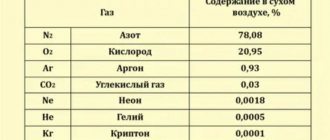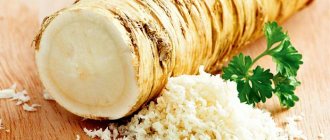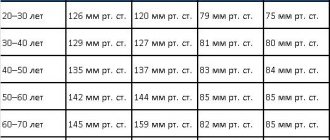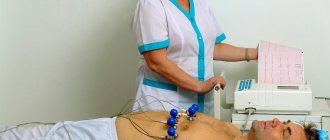High blood pressure is a pathological human condition that entails a number of problems.
Ignoring the disease can lead to an uncontrolled increase in blood pressure and the appearance of complications that will aggravate the patient’s condition.
The lack of therapy in this case can lead to catastrophic consequences, namely death.
If you regularly observe deviations in blood pressure from the norm, you should seek medical help.
What blood pressure is considered normal?
The force of the blood flow on the walls of the arteries/vessels is called blood pressure, which depends on the work of the heart, its strength, speed and volume of blood flow.
Blood pressure has upper and lower values. SBP - systolic blood pressure value (upper) reflects the moment the heart contracts when pushing blood into the system. DBP - diastolic (lower) demonstrates the pressure in the arteries when it relaxes.
If blood pressure = 120/80 mm Hg, then this is considered normal for an adult. The standard blood pressure value can vary depending on a person’s age, lifestyle, and body characteristics.
The indicators depend on age as follows (in mmHg):
- 16-20: SBP – 100-120, DBP – 70-80;
- 20-40: SBP – 120-130, DBP – 70-80;
- 40-60: SBP – up to 140, DBP – up to 90;
- over 60 : SBP – 150, DBP – 90.
It can be seen that over the years the pressure increases slightly. And what is considered normal for a boy or girl may indicate a disease in older people.
Ideas about the value of normal pressure have changed. If several decades ago it was believed that blood pressure increases linearly with age, now such a strict dependence has been abandoned.
And exceeding the level of 150/90 is considered dangerous. This value can be considered normal only conditionally, even for old age. Very often, such a blood pressure value may indicate the presence of hypertension. But the blood pressure is 100/60 mm Hg. is considered abnormally low and requires diagnostics of the body to identify existing diseases.
Pulse pressure (the difference between SBP and DBP) beyond the range of 30-55 also indicates the presence of some pathology.
Pulse does not have a direct relationship with pressure. Tachycardia (rapid pulse) does not always indicate hypertension, and bradycardia (rare pulse) does not always indicate hypotension.
The pulse sometimes increases with low blood pressure, as the body strives to make up for insufficient blood circulation.
Blood pressure is measured only in the absence of physical activity, when the body is at rest.
What is blood pressure
Blood pressure reflects the force of blood moving through the vessels. There are two types:
- systolic, that is, a recorded pressure indicator at the moment when the heart muscle contracts;
- diastolic, the level of pressure at the moment of relaxation.
Each indicator has its own norms, but diastolic should always be less than systolic.
What is the highest blood pressure a person can have?
WHO recommends that blood pressure exceeding 140/90 without taking blood pressure-lowering medications is considered arterial hypertension (HTN), primary or secondary.
Hypertension is primary hypertension. The reasons for it are not fully understood, but there are a number of factors that provoke its development:
- hereditary predisposition;
- prematurity at birth;
- overweight (every 10 kg above normal exceeds SBP by 5 mmHg);
- salt intake more than 5 mg per day;
- smoking and alcohol;
- inactivity;
- chronic stress, increased noise levels, polluted environment.
Secondary hypertension occurs in the presence of a specific pathology:
- kidneys – congenital absence, pyelonephritis, polycystic disease, tumors, etc.;
- endocrine system – thyroid/adrenal diseases, acromegaly;
- aortas – heart defects (congenital), aortitis;
- nervous system – encephalitis, brain tumors.
In addition, complications during pregnancy, as well as taking certain medications or drugs, can be causes of secondary hypertension. The highest blood pressure in a person is a hypertensive crisis. This condition occurs when indicators reach and exceed 180/120 mmHg.
SBP indicators are in the range of 240-260 mm Hg. and DBP – 130-160 mm Hg. are considered critical.
Folk remedies
The highest blood pressure in a person, where and when the unpleasant situation occurred does not matter, can be reduced in time. The main thing is to monitor your health and constantly monitor your blood pressure. In some cases, recipes from “grandmother’s chest.”
The most popular plant that helps improve the condition is lingonberry. It is the composition of this fruit that has a positive effect on reducing blood pressure. The simplest recipe: 50 ml of berry juice per 150 ml of water. The mixture must be infused and then drunk; if the drink is unsweetened, honey can be added. You should drink the infusion daily after meals, 100 ml.
An excellent remedy for reducing blood pressure is honey, especially buckwheat. One spoon of honey can be mixed in still water and drunk on an empty stomach in the morning. You should be treated in this way for at least 10 days. Honey can be combined with beetroot and lemon juice, which also have properties to lower blood pressure.
Rowan (chokeberry) has excellent properties. The juice is squeezed out of the fruits of the tree and consumed after meals, one tablespoon at a time. You should be treated in this way for 14 days.
Lethal pressure: indicator (how much?)
If the upper blood pressure reading reaches 300 mm Hg, this value is considered fatal. Irreversible destructive processes begin in the body.
Despite such high pressure, the level of blood supply to the organs becomes very low, and hypoxia develops. The brain, which has a unique circulatory system unlike other organs, is especially sensitive to a lack of oxygen.
The vascular ring located in the brain can function normally only with SBP values in the range of 80-180 mmHg.
At high levels, autoregulation of its tone is disrupted, gas exchange is disrupted, and vascular permeability jumps sharply upward. Acute hypoxia appears, followed by ischemia. If the pressure is not reduced at this moment, a fatal ischemic stroke occurs.
For the brain, the SBP level exceeds 180 mm Hg. is very dangerous.
How dependent are these indicators?
At a diving depth of 10 meters, the pressure is 1 atmosphere; as the distance is exceeded, it slowly increases. If you descend 100 meters, the sensation will be the same as the body experiences in a steam boiler.
At the same time, the pressure created by water at the bottom of the lake is not always commensurate with what was initially calculated. The indicators here are as follows:
- 10 m - the increase is 100%, that is, instead of one atmosphere, two appear;
- 20 m - the figure is only 50%;
- 40 m - it already reaches 25%;
- 60 m - the level drops to 15–20%.
Each object immersed in water additionally experiences hydrostatic pressure; this indicator is considered excessive.
The relationship between depth and pressure was first discovered while studying how the human body changes when at depth. This also explains the fact that when deeply immersed, people cannot inhale oxygen, even if it is connected.
In this case, it is the difference between the two pressure levels that affects how strong the pressure class becomes that affects the chest. Therefore, during a deep dive, the chest simply ruptures, even if the person is connected to an oxygen tank.
Signs of hypertension
Hypertension does not always have pronounced symptoms, and at the very beginning they may be completely absent. Therefore, people falling into the categories listed above need to monitor their blood pressure quite often. The same requirement applies to older people who have age-related increases in blood pressure.
A person with high blood pressure may have symptoms:
- directly related to high blood pressure : headache, especially in the back of the head, observed in the morning, dizziness, palpitations, fatigue;
- appearing due to vascular damage in hypertension : nosebleeds, the presence of blood in the urine, vision problems, shortness of breath, pain in the chest area;
- occurring with secondary hypertension : thirst, frequent urination, muscle weakness, rapid weight gain, mental imbalance.
With high blood pressure, all organs suffer. Long-term hypertension leads to damage to the kidneys, retina, heart, and brain.
Causes of increased blood pressure
It is believed that primary hypertension develops due to impaired arterial tone, which leads to an increase in blood pressure. And the tone of the arteries can change from external factors, such as:
- irritability, and as a consequence the production of excess stress hormones;
- lack of physical activity;
- abuse of salt and alcohol;
- smoking;
- age-related changes.
What to do if your blood pressure rises?
At the first signs of high blood pressure, you should not immediately resort to pills. You can try using traditional herbal medicine methods:
- hawthorn - especially effective in combination with rose hips, quickly restores heart function and improves blood circulation;
- valerian root with flax seeds – normalizes blood pressure, providing a mild sedative effect;
- therapeutic breathing exercises - eliminates weakness and lowers blood pressure (if it is up to 160/120 mm Hg). A plastic bottle with a cut off bottom and an open cap is used as an inhaler. Breathe from the wide part;
- massage of tight neck muscles . A special neck complex, performed for 10 minutes, helps relieve spasms;
- self-massage of the shells of the ears - rubbing is carried out for 3-5 minutes, allows you to reduce blood pressure that is not too high;
- warm bath with salt (no more than 10 tbsp) – taken for 10-15 minutes, it relaxes and allows you to fall asleep faster;
- walk – walking for half an hour at a fast pace will help normalize blood pressure after stressful situations;
- A dairy-vegetable diet leads to a sustained decrease in blood pressure.
Bisoprolol tablets
All of the above methods are suitable only in the case of a slight increase in blood pressure that is not sustainable. If there is a sharp increase in indicators, medical attention is necessary.
If blood pressure is high, determined using a tonometer, and it is impossible to quickly visit a doctor, you should take the emergency medications recommended by doctors: Bisoprolol, Capoten (Captopril), Nifedipine (Corinfar).
It is necessary to measure blood pressure also after performing herbal procedures or taking medications.
How is hypertension treated?
The mistake of most hypertensive patients is self-medication. Thinking that this will lead to a positive result, a person can harm himself even more.
In order to cope with high blood pressure, you need to contact a qualified specialist who will identify the real cause of the pathology. If the patient constantly lowers his blood pressure with the help of drugs without affecting the root cause, then the disease can develop rapidly. This can be fatal.
The doctor will conduct a full examination of the patient and prescribe a series of tests that will help in making a diagnosis. Only after this will the doctor be able to prescribe competent therapy that will eliminate the root cause of unstable blood pressure.
If blood pressure rises due to constant nervous tension, then mild sedatives are prescribed. If the patient’s psycho-emotional state is in a deplorable state, then specialists resort to the help of antidepressants. Such drugs are sold only with a prescription.
The most common groups of drugs used to combat hypertension:
- calcium antagonists;
- beta and alpha blockers;
- ACE inhibitors;
- sartans.
Combination medications are often used, which have several active substances and act on several causes of increased blood pressure at once.
When prescribing therapy, the patient may be referred to undergo physiotherapy. This method alone will not lead to a cure, but in combination with drug treatment, the effect will not be long in coming.
While undergoing treatment, a hypertensive patient should not forget that his lifestyle must also undergo some path of change. For example, the patient must definitely quit smoking and drinking alcoholic beverages. These bad habits have a detrimental effect on the condition of blood vessels.
You need to reconsider your diet and activity, eliminate all harmful foods and add minimal physical activity.
Impact on biologically active points
This method allows you to use the power of nature: on the human body there are projections of all internal organs, competent influence on which allows you to positively and effectively influence them without the use of harmful methods (taking synthetic drugs, using electrotherapy and surgery).
What to do during a hypertensive crisis (HC)
If your blood pressure reaches a critical level, you must immediately call an ambulance.
In case of uncomplicated HA, this pressure should be reduced very slowly, every 2 hours up to 25%.
With a rapid decrease in blood pressure, hypoperfusion may develop - impaired circulation in tissues/organs . Before the ambulance arrives, you can put Nifedipine or Capoten under the patient’s tongue so as not to aggravate his condition.
Complicated HA threatens with fatal complications: stroke, pulmonary edema, etc. This condition is especially dangerous in pregnant women. In this case, parenteral administration of drugs and urgent hospitalization are necessary to reduce pressure, the decision about which is made by the ambulance team called.











